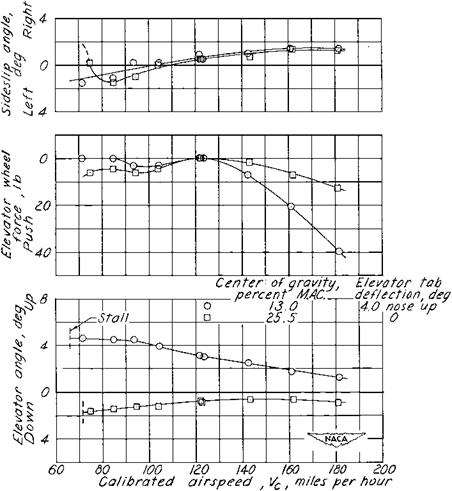Two Famous Airplanes
NACA measured the flying qualities of the Supermarine Spitfire VA fighter in 1942 and the Douglas DC-3 transport in 1953, both at the Langley Laboratory. These airplanes had been built in large numbers, had served magnificently in World War II, and had inspired great affection among their pilots. Yet neither of these famous airplanes had the specified
|
Figure 3.15 The venerable Douglas DC-3 exhibits static longitudinal instability in the normal rated power, clean configuration, at an aft center of gravity position of 25.5 percent MAC. (From Assadourian and Harper, NACA TN 3088, 1953) |
level of the most basic stability of them all, static longitudinal stability, as measured by the elevator angles required for steady flight at various airspeeds. This form of stability is often called stick-fixed stability.
The Spitfire shows neutral stick-fixed stability under all flight conditions. The DC-3 is stable only in power-off glides or with cruise power. With normal rated power or in a power approach condition at aft loadings, increasing amounts of down elevator are needed as the airspeed is reduced, along with push column forces (Figure 3.15). For both airplanes there are other less striking deviations from NACA and military stability and control specifications. What should be made from all of this?
The Spitfire and DC-3 cases should not furnish an excuse to dismiss flying qualities requirements. It is reasonable to assume that if the Spitfire and DC-3 were longitudinally stable under all flight conditions, both of these fine airplanes would have been even better. In fact, the Spitfire Mark 22, developed at the end of the war, had a 27 percent increase in tail areas and flew “magnificently,” according to one account. The bottom line is that
nobody has ever found it feasible to run definitive, statistically valid experiments on the value of good flying qualities in terms of reducing losses in accidents or success in military missions. Instead, we rely on common sense. That is, it is highly plausible that good handling qualities in landing approach conditions will reduce training and operational accidents and that precise, light, effective controls will improve air-to-air combat effectiveness. That plausibility is essentially what energizes the drive for good flying qualities, in spite of apparent inconsistencies, such as for the Spitfire and DC-3.














